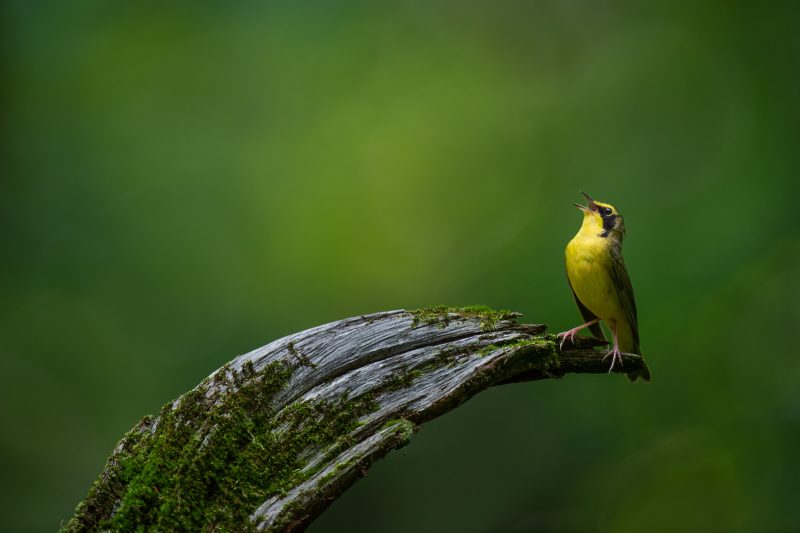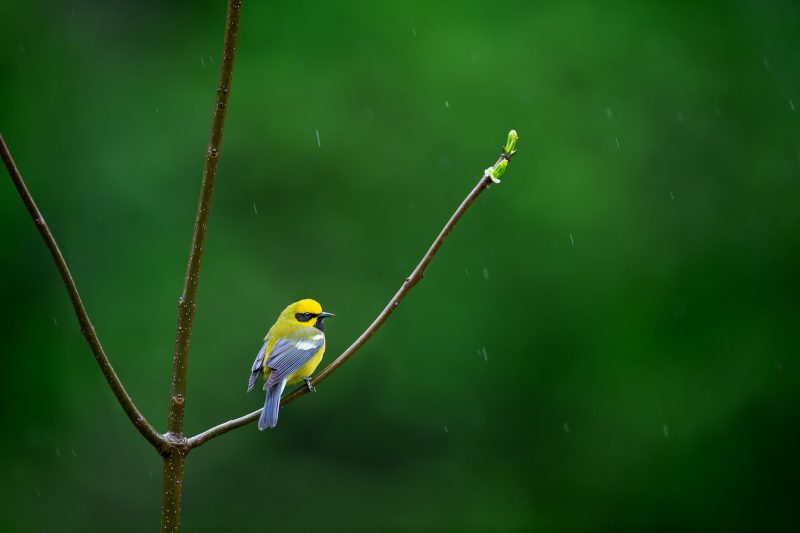How to Use Negative Space in Your Wildlife Photos

The use of negative space in wildlife photos is often not thought about or deliberately used. However, using negative space in your wildlife photography can help to enhance the photo when your goal is not simply a frame-filling subject.
Negative space can help to emphasise small size, include additional colour in a foreground or background, show off a pleasing perch, include habitat that tells a story about where the subject lives, and include a pleasing bokeh in your photo.


What is negative space?
Negative space is typically the part of a photo that is non-distracting and not your subject. Often, this refers to empty space in the background or foreground. That space can be filled with a smooth out of focus area or sometimes with an additional texture or habitat.
But be careful not to let the extra space distract from your subject. Negative space should complement your main subject, or even help to make it stand out more.
It may sound contradictory that including more space around your subject can help it stand out, but hopefully I can show you some examples of how that works.
How to use negative space in photography
1. Emphasising small size
Showing the relative size of your subject can be achieved by photographing it next to something familiar to most people. For example, photographing a tiny bird perched on or near a small flower can give the viewer something to compare the bird to.
In the example below, a northern parula looks small next to the flowering blossoms of a cherry tree. The negative space around the bird helps to make it look even smaller in the overall space.
Even without a comparison object, using negative space alone may help to show how small the subject is as well.
In the images below, you can see how a lesser yellowlegs appears small in a vast expanse of water, and a baby piping plover seems minuscule in the wide-open beach.

2. Including additional colour with negative space
When a background or foreground provides a pleasing out of focus colour, including more negative space can help show off more of that colour. If the colour is complementary to the subject, why not include more of it? The use of negative space with smooth out of focus colour is also a way to help an image feel more balanced.
This is also where composition comes into play. It is often best to have your subject facing into the frame, which means including more space in that direction.
If you are using a AF-S focusing mode you can focus on your subject, lock focus, and recompose to include more space and colour in the direction the subject is facing. If you are using a continuous focusing mode, the use of back button focus to either lock focus or stop focus is required to compose your subject off-centre.
The other option is to move your focus point around the frame to compose with more negative space but, with wildlife, this can cost you valuable time and you may miss the shot. Often locking focus and recomposing is the fastest way to achieve this.
Using negative space with this tricolored heron allowed for a balanced composition with a pleasing blue out-of-focus sky and the water. Since nothing else is in focus but the subject, the negative space does not distract but instead adds to the photo. Additionally, including the negative space allowed for the full reflection of the bird to be included.
This hooded merganser drake, floating on a calm pond, had some beautiful golden sun illuminating the distant shoreline which was reflected in the water. Again, including negative space in the direction the duck is looking allows for a more balanced composition that includes more of the beautiful golden colour.
Read more: Backlighting in Wildlife Photography – Creative Use of Light
It also allows for the image to not feel cramped. While the viewer may see less detail on the duck itself, the overall scene is hopefully more appealing with the included negative space than it would be if it were cropped in much closer.
In the example above, the negative space includes beautiful colours of pastel green, purple, and pink from the dawn sky. In addition to the pleasing colours, the viewer also gains some context about where this least tern lives. You can now see that this bird is on a beach with green dune grasses in the background.
Using black or white as a negative space colour can also create some very dramatic and minimalistic photos. The absence of colours makes black or white negative space particularly unique in that the subject usually really stands out.
This is often a time for complete manual exposures, since all-black backgrounds tend to cause the camera to overexpose the subject; the reverse is true for white backgrounds often resulting in underexposed subjects.
Read more: How to Rescue Over and Underexposed Photos
Taking full control with manual exposure and dialing in a good exposure on your subject is key.
3. Including ornate perches
Capturing photos with pleasing negative space can sometimes allow you to include part of a perch, or the entire perch, when it makes sense with bird photography.
It is not very often that a bird lands on just the right perch but, when it does, sometimes not filling the frame allows you to include more of the perch. In these cases, the perch is almost as much the subject as the bird. The background, however, should be clean and allow for the negative space to be smooth or at the very least not distracting.
Above, a Kentucky warbler sings out while perched on a lovely curved stump with ornate moss. Thanks to a distant background of branches and leaves, the negative space is a lush green that helps make the bird stand out.
Read more: How to Create a Beautiful Bokeh
Next up – a chestnut-sided warbler perched on a thorny branch, along with a bright green vine wrapped around it, stands out wonderfully against a solid black background. The negative space here allows more of the perch to be included and gives the bird space to be singing its song “into”.
In the photo below, the space above the common yellowthroat allowed for the inclusion of the vine that seems to be magically hanging above the bird’s head. Generally, a dark green and black background make for no distractions and the bird, as well as the leaves and vine, all stand out nicely.
The use of negative space doesn’t only have to apply to the perch, as in the case of the Florida burrowing owl below. The negative space of the dusk gradient sky also includes the out of focus palm tree. This helps to give a great sense of place and more context to the image. Using negative space allows this photo to tell more of a story.
Another great use of negative space can be to include more precipitation. Here a photo of a Lawrence’s warbler uses negative space to include the entirety of the perch the bird is on, as well as more of the falling raindrops.
Read more: How to Get Rain & Snow Streaks
4. Including more habitat
One of the most important uses of negative space can be to include more of your subject’s habitat. This helps to inform the viewer much more about where the subject lives and what it looks like there. This is a great way to add to the story of a wildlife photo, the challenge can be allowing the subject to stand out.
Understandably, including more habitat in a photo can easily lead to more visual distraction. When done properly, the included habitat allows the main subject to still shine even though it may add some slight visual distraction compared to an entirely out of focus background and foreground.
This use of negative space can be the most challenging but the most rewarding when it works out. One key is to make sure there is a good distance directly behind your subject. The farther away your background is, the more out of focus (and less distracting) it will be.
Lighting is key here, as well as finding backgrounds that are monotone and don’t include a lot of bright highlights. Remember, you are purposefully making your subject smaller in the frame. By including more habitat, you must do your best to make the negative space be pleasing to the viewer and add something to the image.
A Louisiana waterthrush sings while perched on a branch over a small stream. Including the stream and moss-covered rocks is important because it shows the habitat these unique warblers live in.
The use of backlight against a dark tree line helps this short-eared owl stand out and the negative space helps to show the open field habitat these birds hunt in.
A beautiful hooded warbler singing out while perched in the lush habitat these birds live in. In this example, there is just enough distance from the subject to the background that the background is out of focus enough so that it is not a distraction but adds context to the overall photo.
Shooting at a wider aperture with shallow depth of field helps both to capture a quality photo in low-light conditions as well as make the subject stand out in the scene.
5. Negative space and bokeh
The last great use of negative space is to include a nice bokeh. This can often look great when including lots of specular highlights.
Bubbles, ripples in water, sand, or anything else that reflects small points of light can all make for a great look when thrown out of focus. These tiny points of light can become large balls of light that can make very interesting patterns.
The foreground can be more important than background when taking advantage of this type of negative space. Including a lot of foreground space can allow you to get very close to these points of light (or whatever you are using to create the bokeh).
Lastly, it often helps to have the sun behind your subject (backlit) to help make things glitter. It’s not always a requirement, but generally works better to create sparkling points of light or bright areas filtering through trees and leaves.
In conclusion
Hopefully, you can put into practice some of these techniques to capture more creative and unique wildlife photography that takes advantage of negative space.
While capturing close-up and detailed photos of wildlife can often be beautiful and powerful, sometimes backing up and looking at the entire scene can allow for a photo that takes advantage of negative space and stands out from the crowd.





















